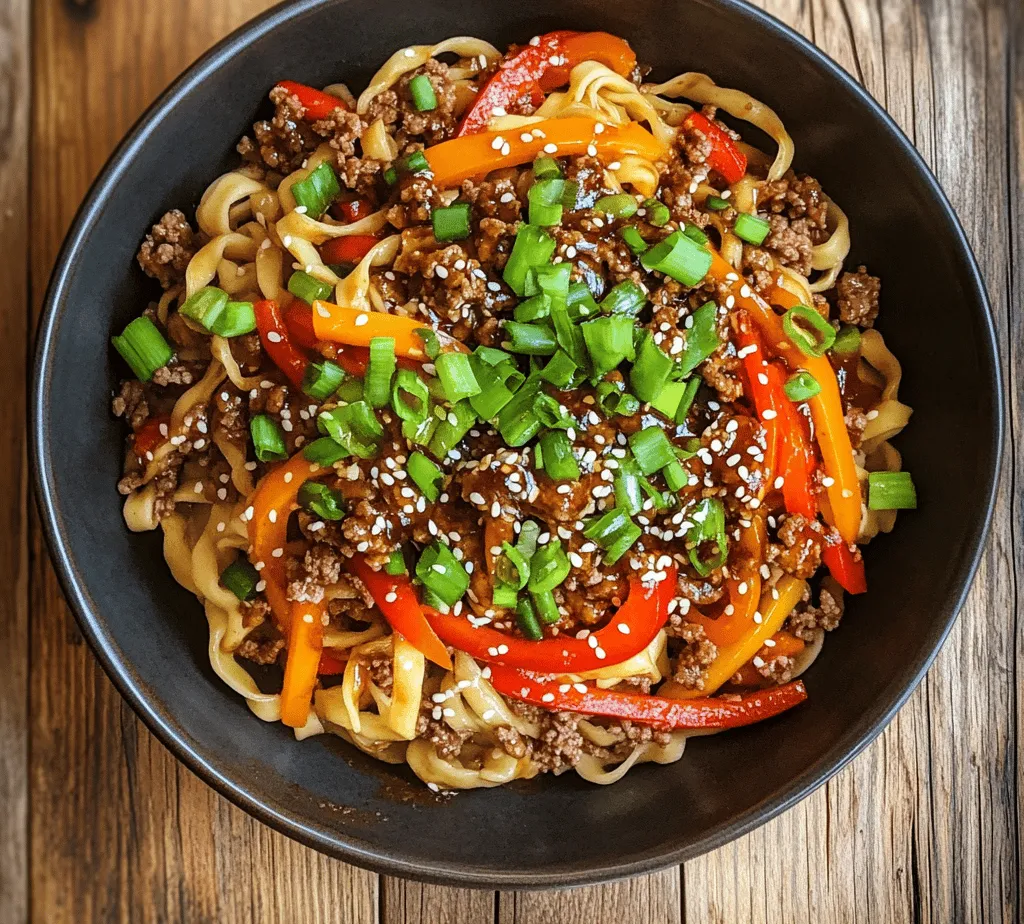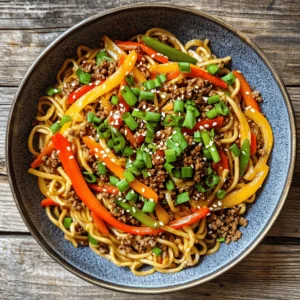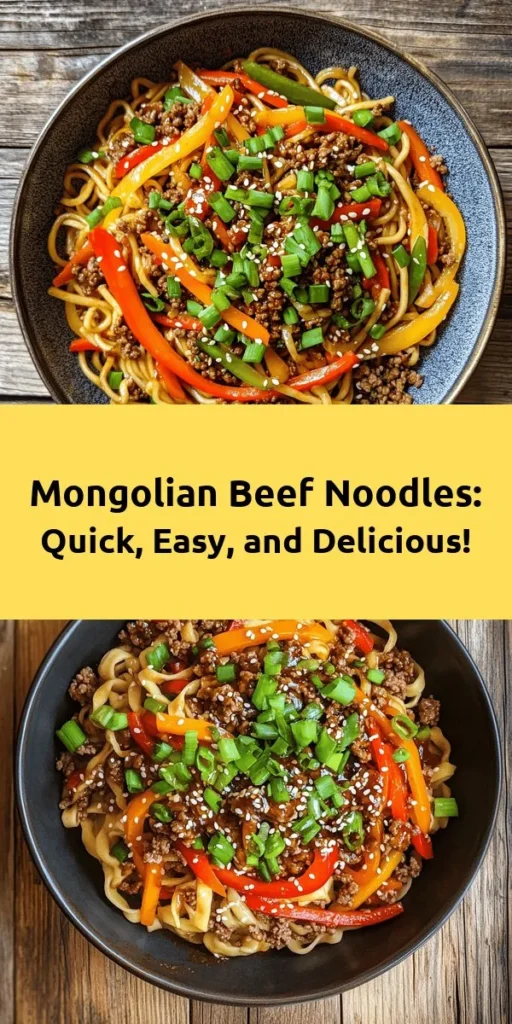Introduction
In this article, we invite you on a culinary journey to the heart of Mongolian cuisine with a delightful recipe for Mongolian Ground Beef Noodles. This dish, featuring tender ground beef and flavorful vegetables tossed with egg noodles, is not only quick to prepare but also rich in taste and texture. Perfect for a weeknight dinner or a weekend gathering, this recipe balances savory and sweet elements, making it a crowd-pleaser for all ages.
Mongolian cuisine is often characterized by its hearty and robust flavors, stemming from its nomadic heritage. The use of fresh, natural ingredients reflects the country’s vast landscapes and agricultural bounty. The combination of ground beef with vegetables and noodles creates a comforting meal that encapsulates the essence of Mongolian cooking. As you prepare this dish, you’ll not only enjoy the delightful flavors but also connect with a rich culinary tradition.
Understanding the Essence of Mongolian Cuisine
The Cultural Significance of Mongolian Dishes
Mongolian cuisine is deeply rooted in the traditions and history of the region. Its culinary practices have evolved over centuries, influenced by the nomadic lifestyle of the Mongolian people. Traditionally, meat – particularly mutton, beef, and horse meat – has been a staple, given the vast grasslands that provide grazing for livestock.
In addition to meat, dairy products, such as milk, yogurt, and cheese, play a significant role in the diet, reflecting the pastoral lifestyle of the Mongolian people. The use of simple but flavorful cooking techniques, like boiling and stewing, is common, allowing the natural flavors of the ingredients to shine through.
Understanding this background can enhance your appreciation for the flavors and ingredients used in this recipe. Mongolian dishes often highlight the harmony between meat, vegetables, and noodles, illustrating a balance that is both satisfying and nourishing.
Key Ingredients in Mongolian Cooking
An overview of essential components commonly found in Mongolian dishes reveals the depth of flavors that characterize this cuisine. Soy sauce, hoisin sauce, and sesame oil are pivotal in Mongolian cooking, serving as key flavor enhancers that give dishes their distinct taste profiles.
– Soy Sauce: This staple ingredient adds a rich umami flavor, enhancing the savory elements of the dish while also providing a beautiful color to the final presentation.
– Hoisin Sauce: Known for its sweet and tangy profile, hoisin sauce adds complexity and a hint of sweetness that balances the saltiness of soy sauce.
– Sesame Oil: With its nutty aroma, sesame oil not only infuses dishes with flavor but also offers health benefits, including antioxidant properties.
These ingredients come together to create a robust flavor base for Mongolian Ground Beef Noodles, making each bite a delightful experience.
Ingredients Breakdown
Fresh and Flavorful Components
Ground Beef
When selecting ground beef for this recipe, consider using a lean cut to ensure the dish remains juicy without being overly greasy. Ground beef is an excellent source of protein, iron, and essential vitamins, making it a nutritious choice. Its rich flavor profile complements the other ingredients in the dish, allowing it to absorb the sauces and spices beautifully.
Vegetables
Incorporating a variety of vegetables not only enhances the nutritional value of the dish but also adds vibrant colors and textures. For this recipe, bell peppers, carrots, and onions are ideal choices.
– Bell Peppers: These colorful vegetables are rich in vitamins A and C, contributing to the dish’s health benefits while providing a slight sweetness.
– Carrots: Carrots bring a natural sweetness and crunch, along with significant amounts of beta-carotene, which is beneficial for vision and skin health.
– Onions: Onions add depth and aroma, enhancing the overall flavor profile of the dish. They caramelize beautifully when sautéed, contributing to the dish’s savory undertones.
Noodles
Egg noodles are the traditional choice for this recipe, offering a chewy texture that pairs perfectly with the savory beef and vegetables. Their versatility allows them to absorb flavors well, making them an excellent vehicle for the sauces used in this dish. If you prefer an alternative, rice noodles or whole-grain pasta can also work, providing a different texture while still maintaining the dish’s integrity.
Sauces and Seasonings
Soy Sauce
Soy sauce is a cornerstone of flavor in many Asian cuisines, and in this recipe, it plays a crucial role. The umami flavor enhances the savory notes of the ground beef while also contributing to the overall seasoning of the dish. When using soy sauce, opt for low-sodium varieties if you’re watching your salt intake, as this can help balance the overall flavor without overwhelming the dish with saltiness.
Hoisin and Oyster Sauce
Hoisin sauce, with its complex flavor profile, adds sweetness and depth, making it a fantastic complement to the savory elements of the ground beef. Oyster sauce, often used in Mongolian cooking, provides a unique depth of flavor and enhances the dish’s umami characteristics. Together, these sauces create a beautiful harmony of flavors that elevate the dish.
Sesame Oil
Finishing with sesame oil is essential, as it adds a distinct aroma and richness. Just a drizzle at the end of cooking can transform the entire dish, leaving a lingering nutty flavor that enhances each bite. Additionally, sesame oil contains healthy fats and antioxidants, making it a flavorful and nutritious addition to your meal.
Step-by-Step Recipe Instructions
Cooking the Noodles
To start your Mongolian Ground Beef Noodles, it’s essential to cook the egg noodles perfectly. Begin by bringing a large pot of salted water to a rolling boil. Once boiling, add the egg noodles and cook according to the package instructions, usually around 4 to 6 minutes, or until they reach an al dente texture.
Tip: To prevent the noodles from sticking together, stir them gently during the first couple of minutes of cooking. Once done, drain the noodles in a colander and rinse them under cold water to halt the cooking process. Drizzling a little sesame oil over the noodles can also help keep them separate and add a touch of flavor.
Sautéing the Aromatics
While the noodles are cooking, it’s time to prepare the flavor base for your dish. Heat a large skillet or wok over medium-high heat and add a splash of vegetable oil. Once the oil is hot, add minced garlic and freshly grated ginger. Sauté these aromatics for about 30 seconds, or until they become fragrant. This step is crucial, as it sets the stage for the entire dish, infusing the oil with rich flavors that will meld beautifully with the beef and vegetables.
Browning the Beef
Next, add the ground beef to the skillet, breaking it apart with a spatula. Cook the beef for about 5 to 7 minutes or until it is browned and cooked through. Ensure that the beef is evenly browned, as this enhances the flavor through caramelization.
Technique Tip: Avoid overcrowding the pan, as this can cause the beef to steam rather than brown. If necessary, cook the beef in batches. Once the beef is browned, drain any excess fat if needed, then season it with soy sauce, hoisin sauce, and oyster sauce. Stir well to incorporate the sauces, allowing the flavors to deepen as it continues to cook.
Incorporating Vegetables
Finally, it’s time to add the vegetables. Start with sliced bell peppers, julienned carrots, and diced onions. Sauté them with the beef for an additional 3 to 4 minutes, or until the vegetables are tender yet still crisp. The goal is to maintain their vibrant colors and nutritional benefits while allowing them to absorb the flavors from the beef and sauces.
Stir everything well, ensuring that the vegetables are evenly coated with the savory sauce mixture. As the vegetables cook, they will release their natural sweetness, enhancing the overall flavor of the dish.
In the next part of this article, we will explore additional cooking tips, how to serve this delectable dish, and answer some common questions about preparing Mongolian Ground Beef Noodles. Stay tuned for the continuation of this culinary adventure!

Timing is Key: Adding Vegetables for Crispness and Vibrancy
When it comes to preparing Mongolian Ground Beef Noodles, the timing of adding vegetables plays a crucial role in achieving that perfect crunch and vibrant color. Start by preparing your vegetables ahead of time, ensuring they are washed, peeled, and sliced into uniform pieces. This preparation will allow for a seamless cooking process, ensuring that you can add them at the right moment.
Once your ground beef is cooked and the sauce is simmering, it’s time to introduce the vegetables. Add heartier vegetables like bell peppers, carrots, and snap peas first, as they require a bit more cooking time. Stir-fry them for about two to three minutes until they start to soften but still retain their crunch. Then, introduce more delicate vegetables such as bok choy or green onions. These should only be added for an additional minute or two, just enough time to soften slightly while preserving their color and nutritional value. This technique not only enhances the dish’s texture but also its visual appeal, making your meal as stunning as it is delicious.
Preparing the Sauce
A well-balanced sauce is the heart of any noodle dish, and this recipe is no exception. To create a sauce that complements the flavors of the Mongolian Ground Beef Noodles, you will need a combination of savory and sweet elements. Begin by combining soy sauce, which provides a rich umami flavor, with oyster sauce for depth. Add a splash of rice vinegar to introduce acidity that balances the sweetness of the dish.
To enhance the flavor further, include minced garlic and ginger, which offer a fragrant aroma and warmth. A touch of brown sugar or honey can be added for sweetness, which is characteristic of Mongolian cuisine. For a bit of heat, consider incorporating red pepper flakes or a dash of sesame oil. Mix these ingredients in a bowl until well combined and set aside. This sauce will not only coat the noodles but will also harmonize the flavors of the beef and vegetables, creating a memorable dish.
Combining Ingredients
With your beef, vegetables, and sauce ready, it’s time to bring everything together. In a large wok or skillet over medium-high heat, add the cooked noodles. It’s essential to use noodles that have been rinsed in cold water after cooking to prevent them from sticking together. Once the noodles are in the pan, pour the prepared sauce over them, ensuring every strand is coated.
Next, add the beef and vegetable mixture to the noodles. Using tongs or a spatula, gently toss all the ingredients together. This process should be quick, ensuring the noodles do not overcook while allowing the sauce to evenly distribute across the noodles, beef, and vegetables. The key is to combine everything without breaking the noodles, maintaining their integrity and texture. Cook for an additional minute, allowing the ingredients to meld together and the flavors to deepen before removing from heat.
Garnishing and Serving Suggestions
Garnishing your Mongolian Ground Beef Noodles is an essential step that elevates both presentation and flavor. Consider topping the dish with freshly chopped cilantro or parsley for a pop of color and freshness. Thinly sliced green onions add a zesty crunch and vibrant green hue, making the dish visually appealing. For those who enjoy a bit of spice, sprinkle some sesame seeds or fried shallots on top for added texture and flavor.
Serve the noodles in large bowls, ensuring that each serving includes a generous portion of beef and vegetables. Pair the dish with lime wedges for a burst of acidity that can cut through the richness, enhancing the overall experience. This dish is perfect for sharing, making it an excellent choice for family dinners or gatherings with friends.
Nutritional Profile of Mongolian Ground Beef Noodles
A well-rounded dish like Mongolian Ground Beef Noodles offers a variety of nutritional benefits, thanks to its diverse ingredients. Understanding the macronutrient composition can help you appreciate the balance it provides.
Balancing Macronutrients
In a typical serving of Mongolian Ground Beef Noodles, you can expect a hearty balance of proteins, carbohydrates, and fats. The lean ground beef contributes a significant amount of protein, essential for muscle repair and growth, while also providing iron and B vitamins.
The noodles, typically made from wheat, serve as the primary source of carbohydrates, fueling your body with energy. Adding a variety of colorful vegetables not only enhances the dish’s flavor and texture but also boosts its fiber content, promoting digestive health. The inclusion of healthy fats, especially if you use a small amount of oil for cooking, supports overall nutrient absorption and contributes to satiety.
Health Benefits of Key Ingredients
The ingredients in this recipe each bring their health benefits. Lean ground beef is a great source of high-quality protein, which helps in muscle building and repair. It also contains essential nutrients like zinc and vitamin B12, crucial for maintaining energy levels and supporting immune function.
Vegetables such as bell peppers and broccoli are packed with vitamins A and C, which are known for their antioxidant properties and immune-boosting benefits. They also provide fiber, which aids in digestion and helps you feel full longer. Additionally, ginger and garlic are not just flavor enhancers; they contain bioactive compounds that may provide anti-inflammatory and immune-supporting properties.
Tips for Customization
Ingredient Substitutions
One of the great things about Mongolian Ground Beef Noodles is its versatility. You can easily customize the recipe to cater to dietary preferences or restrictions. For a vegetarian option, substitute the ground beef with crumbled firm tofu or tempeh, which can absorb the flavors of the sauce beautifully.
If you’re looking to reduce carbohydrates, consider using spiralized vegetables like zucchini or carrots instead of traditional noodles. This variation not only lowers the carb count but also adds more nutrients to the dish. For those with specific veggie preferences, substitute the vegetables in this recipe with your favorites based on seasonal availability, such as mushrooms, spinach, or snow peas.
Flavor Variations
Adjusting the flavor profile of your Mongolian Ground Beef Noodles is simple. If you prefer a spicier dish, add more red pepper flakes or even a splash of hot sauce to the sauce mixture. For a sweeter taste, increase the amount of brown sugar or honey. You might also experiment with different sauces; for instance, adding a bit of hoisin sauce can introduce a sweet and tangy twist.
For a more complex flavor, consider adding spices like five-spice powder or even a hint of curry powder to the beef while it cooks. These variations allow you to tailor the dish to your taste preferences, making it unique every time you prepare it.
Storing and Reheating Leftovers
Proper Storage Techniques
If you find yourself with leftovers, storing them properly is key to maintaining their freshness and flavor. Allow the Mongolian Ground Beef Noodles to cool to room temperature before transferring them to airtight containers. This prevents condensation, which can lead to sogginess.
Store the noodles in the refrigerator for up to three days. For longer storage, consider freezing them in individual portions. Just be mindful that while the noodles can be frozen, some vegetables may lose their texture when reheated.
Reheating Instructions
When it comes time to enjoy your leftovers, reheating is straightforward. If you’ve stored the noodles in the refrigerator, you can reheat them in a microwave-safe dish. Add a splash of water or broth to prevent them from drying out, and cover the dish to retain moisture. Heat in 30-second intervals, stirring in between, until heated through.
For frozen leftovers, it’s best to thaw them overnight in the refrigerator before reheating. Alternatively, you can add the frozen noodles directly into a skillet over medium heat, adding a bit of water to help steam them as they cook. This method ensures that you retain the dish’s original flavor and texture, making for a satisfying meal even after a day or two.
Conclusion
Mongolian Ground Beef Noodles is a versatile and flavorful recipe that captures the essence of Mongolian cuisine. With its balance of savory and sweet notes, it is sure to become a favorite in your household. The combination of tender beef, crisp vegetables, and perfectly cooked noodles enveloped in a delicious sauce creates a dish that is not only satisfying but also visually appealing.
Whether you’re looking for a quick weeknight meal or a dish to impress guests, this recipe delivers both in taste and presentation. Enjoy the experience of preparing and sharing this culinary delight with family and friends. Embrace the richness of flavor, the satisfaction of a homemade meal, and the joy of gathering around the table to share delicious food. Dive into this delightful recipe and make it a staple in your cooking repertoire.



